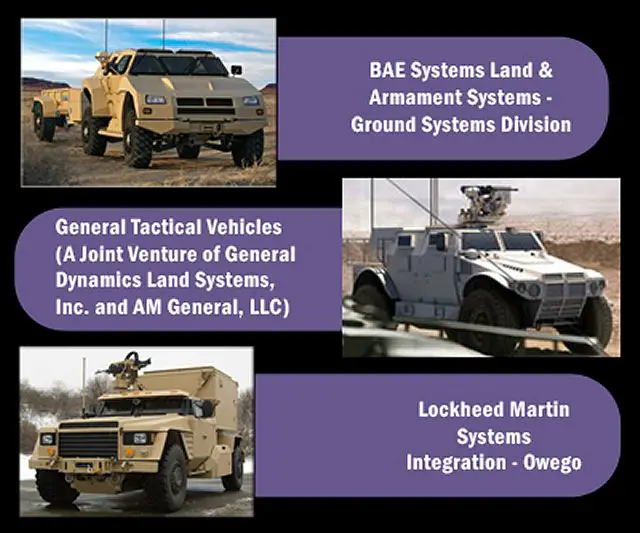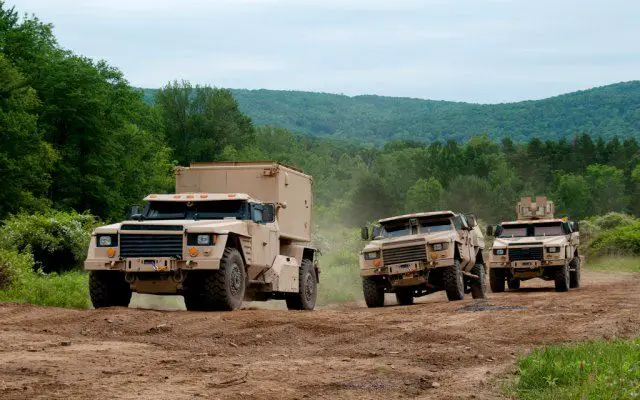| a | |||
United States US Army News |
|||
|
|||
| United States army preparing to produce JLTVs Joint Light Tactical Vehicle. | |||
After
refining requirements during a two-year Technology Development phase for
the Joint Light Tactical Vehicle, Army developers are poised to conduct
a full and open competition geared toward formal production, service officials
said. |
|||
 The three Defence companies which propose vehicles for the JLTV program |
|||
| The Joint Light Tactical Vehicle, or JLTV, will be a next-generation light vehicle designed to bring Soldiers an unprecedented blend of protection, payload and performance, said Tim Goddette, director of Sustainment Systems. The Technology Development, or TD, phase for JLTV development, completed this past May, successfully demonstrated the vehicle's ability to meet a wide range of requirements, including fortified improvised explosive device, or IED, protections designed to withstand blast attacks, off-road mobility, variable ride height suspension, exportable power and essential command, control, communications, computers, intelligence, surveillance and reconnaissance, or C4ISR, capabilities, Goddette said. The 27-month phase included prototype vehicles from three teams of vendors: BAE-Navistar, Lockheed-BAE and General Tactical Vehicles (General Dynamics and AM General). "The purpose of the TD phase was geared toward refining the requirements in order to demonstrate the JLTV's ability to meet the designated capability gaps," Goddette said. "The program has succeeded in identifying and proving out those areas of needed development -- and now the Army is analyzing what trade-offs might be required in order to best pursue an acquisition strategy that both lowers costs and delivers this needed capability to Soldiers." The competitive prototyping and extensive testing pursued during the TD phase was designed to match technological capability with the vehicle's requirements and lower risk for an anticipated production phase, Goddette said. |
|||
 Three different mission types of Joint Light Tactical Vehicles are driven offroad during the Technology Development phase which concluded in May 2011. |
|||
|
We demonstrated that every one of the requirements
was achievable," Goddette explained. "We've learned that some
trade-offs are necessary to pursue an overall strategy that best synchronizes
requirements, resources, mature technologies and a cost-reducing acquisition
strategy."
"We demonstrated not only that the requirements were achievable, but we gained valuable insight into the cost of each capability and effect that one capability might have on another. We've learned that some trade-offs are necessary to pursue an overall strategy that best synchronizes requirements, resources, mature technologies and a cost-reducing acquisition strategy," Goddette said. Operating in today's more budget-constrained fiscal environment, Army developers are working on an approach to JLTV procurement that harnesses the best available technologies while minimizing costs and achieving efficiency in the process, he said. One such approach includes the possibility of buying less add-on armor, known as B-kits, for the vehicles because not every JLTV will need the added protection and new, lightweight materials may likely become available in the future, Goddette said. Due to its enhanced technological capabilities, the JLTV will be able to perform a wide range of missions and perform many roles Humvees are currently unable to do, Goddette said. At the same time, the Army has embarked upon a competitive Humvee recap program aimed at improving the survivability of the existing vehicle that is already in the Army inventory. "The JLTV and Humvee-recap program are designed to complement one another as part of an integrated Light Tactical Vehicle strategy designed to best prepare our force for a range of anticipated future contingencies," Goddette said. "These two competitive efforts are also synchronized with one another to invest a limited amount of resources up front enabling a 'try before we buy' approach and capitalize on the vast experience our industry partners have gained over that past five years." With its off-road ability, blast-protections and on-board electronics, the JLTV will bring a new set of capabilities to the Army and Marines. There
are two different variants or categories of JLTV: |
|||
U.S. Army prepares to produce the first JLTVs Joint Light Tactical Vehicle
- Posted On














